Years active 1927–62 Religion Roman Catholic | Name John Farrow Role Film director | |
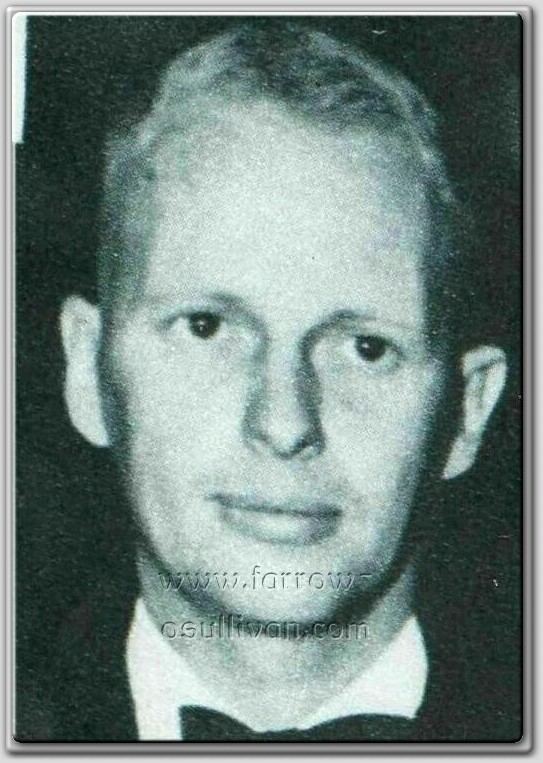 | ||
Full Name John Villiers Farrow Occupation Actor director, producer and screenwriter Grandchildren Ronan Farrow, Soon-Yi Previn, Moses Farrow Movies Similar People | ||
JOHN FARROW TRIBUTE
John Villiers Farrow, KGCHS (10 February 1904 – 27 January 1963) was an Australian-American film director, producer and screenwriter. In 1957, he won the Academy Award for Best Writing/Best Screenplay for Around the World in Eighty Days and in 1942 he was nominated as Best Director for Wake Island. He had seven children by his wife, actress Maureen O'Sullivan, including actress Mia Farrow.
Contents
- JOHN FARROW TRIBUTE
- Early life
- Writer
- Paramount and RKO
- Britain
- Return to Hollywood and arrest
- Warner Bros
- RKO
- War service
- Paramount
- Film noir and westerns
- Later years freelancer
- Personal life
- Death
- Awards and honours
- Australian connection
- Screenplays for unrealized films
- Books
- Play
- References
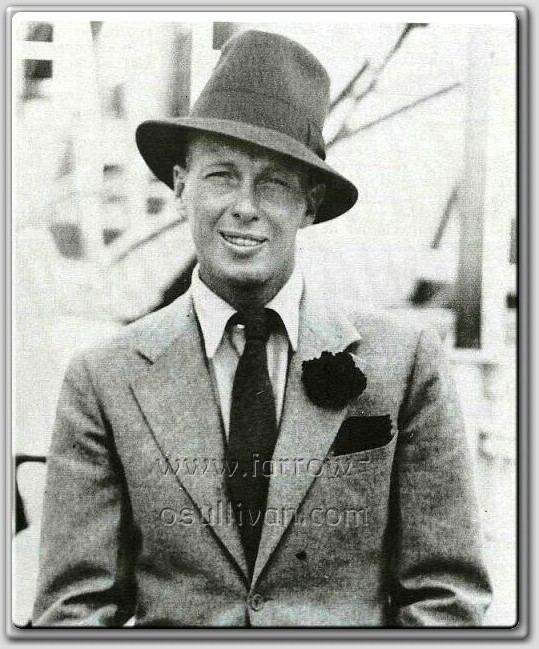
Early life

Farrow was born in Sydney, Australia, the son of Lucy Villiers (née Savage; 1881-1907), a dressmaker, and Joseph Farrow (1880-1925), a tailor's trimmer. His mother died when he was three years old. His parents were both of English descent. Farrow was educated at Newtown Public School and Fort Street Boys' High School and then started a career in accountancy.
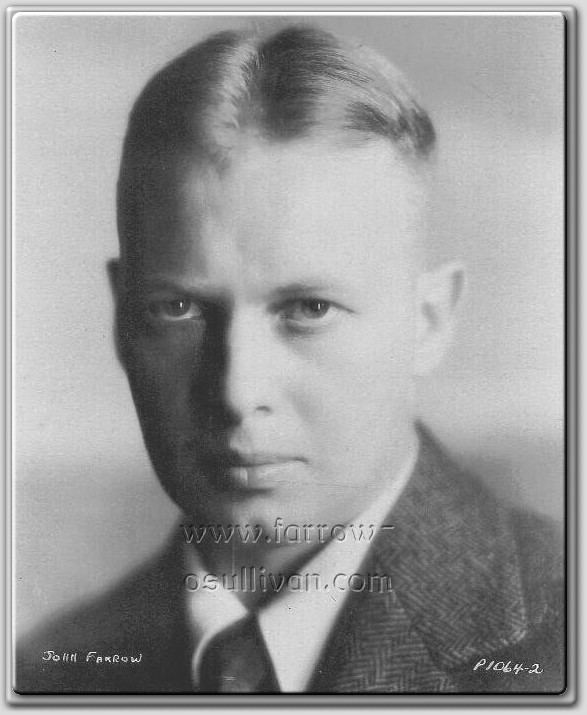
He claimed to have run away to sea in an American barquentine, sailed "all over the Pacific", and fought in revolts in Nicaragua and Mexico. Reaching the United States, he enrolled at the Jesuits' St Ignatius College in San Francisco in 1923, but left after one month.
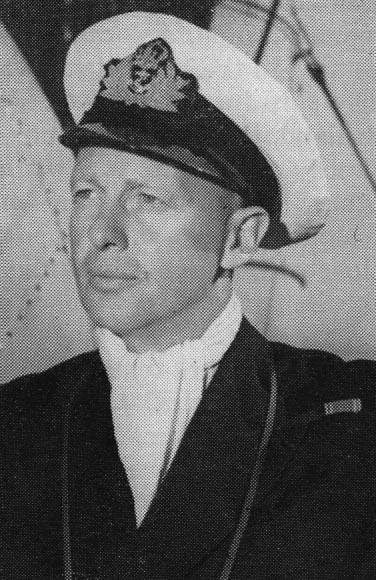
He traveled throughout the Pacific, including Fiji, Hawaii and Guam. On arrival in Hollywood, Farrow fabricated his education, saying he had attended Newington College in Sydney, Australia (he lived in a street below its ovals), Winchester College in England and the US Naval Academy. Many publications and websites still contain this information.
Writer

Farrow started writing while working as a sailor and became interested in screenwriting after a chance voyage in the South Seas with the film-maker Robert J. Flaherty. Re-entering the United States, allegedly by jumping ship at San Francisco, he found his way to Hollywood where from 1927 his nautical expertise brought him work as a script consultant and technical adviser. He had already earned minor recognition as a poet and writer of short stories.
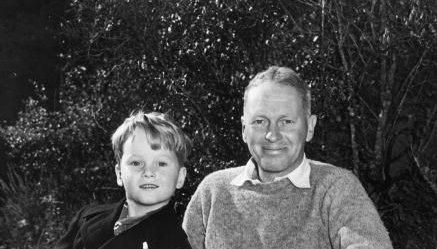
He soon established himself as a notable screenwriter. He worked for DeMille Productions, doing titles for White Gold (1927) and The Wreck of the Hesperus (1927); he also wrote the original story for The Blue Danube (1928) and the script for The Bride of the Colorado (1929). At Warner Bros he wrote A Sailor's Sweetheart (1927) for director Lloyd Bacon.
Paramount and RKO

At Paramount Farrow worked a series of "woman's pictures" Three Weekends (1928), with Clara Bow; The Woman from Moscow (1928) for Pola Negri; The First Kiss (1928), with Fay Wray and Gary Cooper, and Ladies of the Mob (1929) with Bow. At that studio he also made The Showdown (1928), The Four Feathers (1929), The Wheel of Life (1929), A Dangerous Woman (1929) and Wolf Song (1930) with Gary Cooper.
He wrote The Bad One (1930) for United Artists. Shadow of the Law (1930) and Seven Days' Leave (1930) (with Cooper) were for Paramount.
Farrow began to work increasingly at RKO: Inside the Lines (1930); The Common Law (1931), with Constance Bennett, and a big hit; A Woman of Experience (1931) with Helen Twelvetrees;
Britain
He compiled an English-French-Tahitian dictionary and wrote a novel, Laughter Ends (1933), In 1932 he went to England where he wrote The Impassive Footman (1932) for Basil Dean. He worked as a writer and assistant director on G. W. Pabst's film of Don Quixote, and briefly visited Tahiti again.
Return to Hollywood and arrest
Farrow returned to Hollywood and re-established himself as a screenwriter. On 27 January 1933, while dancing at the Cocoanut Grove nightclub, he was arrested for breach of his visa, as part of a general crackdown against illegal immigrants in the film industry. Farrow was charged with making a false statement while entering the US, having claimed he was Romanian. Although threatened with deportation, eventually he was given five years probation, before being acquitted of the charges the following year.
At MGM Farrow wrote Last of the Pagans (1935), partly set in Tahiti, and directed a short, The Spectacle Maker (1934). He received a plum appointment to work on Tarzan Escapes (1936) but the film was subsequently rewritten and reshot.
Warner Bros
In 1930, it was announced that Farrow would direct his own story First Love but this did not materialize. He signed to Warner Bros in 1936 looking to direct and was linked with a number of projects, including a foreign legion story and an adaptation of The Pit and the Pendulum. Farrow finally made his directorial debut in 1937 with Men in Exile, a remake of Safe in Hell (1931).
Following this, he accompanied his wife to Europe, where she was making A Yank at Oxford (1938), lecturing on Father Damien, about whom Farrow had written a book (published in 1937), and receiving a Papal knighthood.
On his return to Hollywood, Farrow resumed working as a B-picture director for Warners: She Loved a Fireman (1937) with Dick Foran and Ann Sheridan; West of Shanghai (1937) with Boris Karloff; Comet Over Broadway (1938) with Kay Francis; Broadway Musketeers (1938) with Margaret Lindsay and Sheridan; My Bill (1938) with Francis; Little Miss Thoroughbred (1938) with John Litel and Sheridan; and The Invisible Menace (1938) with Karloff. He discovered a young Peggy Ann Garner.
Farrow left his contract for a number of months, ostensibly to finish a book he was writing on the history of the papacy, and also due to disputes over the script of Kay Francis's Women in the Wind. After making Women in the Wind (1939) he re-emerged as a contract director for RKO.
RKO
Farrow's tenure at RKO began well with the highly profitable The Saint Strikes Back (1939) , the second in the "Saint" series and the first to star George Sanders in the lead. He followed it with Five Came Back (1939), which, although a "B", became a surprise hit and received excellent reviews.
He followed it with Sorority House (1939), from a script by Dalton Trumbo; Full Confession (1939), with Victor McLaglen; Reno (1939); Married and in Love (1940); and A Bill of Divorcement (1940), a remake of the 1932 Katherine Hepburn film with Maureen O'Hara in the lead.
"I deliberately set out to become the damndest commercial director in the business," he said later. "The only way to get anywhere in hospital is to make money pictures. Then you can get some measure of respect and authority from the studio bosses, and little by little you get to do more of the things you want to do."
War service
Despite his flourishing career and recently having become a father for the first time, Farrow was keen to be involved in World War II. He went to Vancouver in November 1939 and enlisted in the Canadian Navy.
Farrow was appointed lieutenant in March 1940 and assigned to Naval History and the Controller of Information Unit. He worked on anti-submarine patrols and in April 1941 was loaned to the Royal Navy and appointed to HMS Goshawk naval base in Trinidad, and served as assistant to the Senior British Naval Officer, Curaçao. He contracted typhus fever and returned to Naval Headquarters, Ottawa, in late 1941.
It was announced he would direct a Canadian war film starring his wife Maureen O'Sullivan while on leave, but this did not eventuate.
Farrow was invalided out of the Canadian Navy with typhus in January 1942 at the rank of Commander but remained in the naval reserve.
Paramount
Farrow resumed his directing career at Paramount. For the first time, Farrow was directing "A" movies. The association began brilliantly with Wake Island (1942), which earned him an Oscar nomination for Best Director, and was one of the year's biggest hits. He followed it with another war film, Commandos Strike at Dawn (1942), which also proved popular. China (1943), with Alan Ladd and Loretta Young,was another big hit.
In February 1943 Farrow signed a long term contract with Paramount. In July 1943 he served as technical consultant for the proposed Royal Canadian Navy show. He directed The Hitler Gang (1944); Two Years Before the Mast (filmed 1944, not released until 1946), with Ladd; and You Came Along (1945), from a script co-written by Ayn Rand.
In May 1945 Farrow was briefly recalled to active duty, travelling to Britain for work in connection with the Director of Special Services. Shortly after he made Calcutta (1947) with Ladd, though it was not released until two years later, to strong box office.
Two Years Before the Mast was released in 1946 and became the tenth most popular movie of the year. Ladd was meant to star in Farrow's California (1947) but dropped out over money and was replaced by Ray Milland. It was a big hit. Less popular were two films with Sonny Tufts: Blaze of Noon (1947), about flyers, and Easy Come, Easy Go (1947), with Barry Fitzgerald.
Farrow became an American citizen in July 1947.
Film noir and westerns
In 1947 Farrow made one of his most highly regarded films, the noir The Big Clock (1948) with Ray Milland and O'Sullivan. He was reunited with Ladd for a military drama, Beyond Glory (1948), then returned to noir with Night Has a Thousand Eyes (1948), starring Edward G. Robinson from a Cornell Woolrich novel, and Alias Nick Beal (1949), with Milland.
As a change of pace he produced and directed a comedy with Betty Hutton, Red, Hot and Blue (1949), followed by a popular Western with Milland, Copper Canyon (1950). Farrow did some uncredited work on the Ladd Western, Red Mountain (1951), with William Dieterle fell ill. He also published a history of the papacy, Pageant of the Popes (1950).
For Howard Hughes at RKO he directed Robert Mitchum in a noir, Where Danger Lives (1950). Hughes liked Farrow's work enough to hire him again for His Kind of Woman (1951), also with Mitchum, although the film would be extensively re-shot by Richard Fleischer.
Back at Paramount he made Submarine Command (1951) with William Holden. He wound up his contract with a final movie with Ladd, Botany Bay (1952), a half-successful attempt to repeat Two Years to the Mast.
Later years: freelancer
Farrow directed Robert Taylor and Ava Gardner in the MGM Western, Ride, Vaquero! (1953), which was a hit. He made two produced by John Wayne for Wayne's company, Batjac: Plunder of the Sun (1953), an adventure story with Glenn Ford, and Hondo (1953) with Wayne, from a story by Louis L'Amour; the latter especially was popular at the box office.
He made A Bullet Is Waiting (1954) at Columbia, then he had another big hit with Wayne, The Sea Chase (1955), where Wayne played a German sea captain in World War Two. The early part of the film was set in Sydney Australia, although not filmed there.
Farrow was the original director of Around the World in 80 Days (1956) but was fired by producer Michael Todd shortly after filming commenced. However Farrow remained credited for his contribution to the screenplay, which won an Oscar in 1956. He also published a collection of poetry and a biography of Sir Thomas More.
Farrow made two films for RKO, neither successful: Back from Eternity (1956), a remake of Five Came Back, and The Unholy Wife (1957), a failed attempt to launch Diana Dors to US audiences.
He received an offer from Samuel Bronston to make two films, a biography of John Paul Jones and a story of the life of Jesus Christ, which Farrow had been trying to make for years. He directed the first one - John Paul Jones. However he was replaced as director on the second by Nicholas Ray – it was released as King of Kings (1961).
Personal life
Farrow was a notorious playboy in his youth, being linked to Dolores del Río and Diana Churchill among others. He married Felice Lewin in 1924.
In 1934 he became engaged to actress Maureen O'Sullivan and they married on 12 September 1936. Farrow and O'Sullivan had seven children: four daughters, who became actresses, Mia (born 1945), Prudence (born 1948), Stephanie (born 1949), Tisa (born 1951); and three sons, Michael Damien (1939–1958), Patrick Villiers (1942–2009), and John Charles (born 1946). Maureen O'Sullivan was his second wife, after he converted to Catholicism and received an annulment of his first marriage.
Death
Farrow died from a heart attack in Beverly Hills, California at the age of 58 and was buried in the Holy Cross Cemetery, Culver City.
Awards and honours
Australian connection
As one of the few high-profile Australians in Hollywood during the 1930s, Farrow's activities were well covered by the Australian media. He accepted the Oscar won by the Australian documentary Kokoda Front Line! (1943), met Australian Senator Richard Keane, the Minister for Trade and Customs, when he visited Hollywood during the war and offered to assist in the establishment of an Australian information service in the US. He also often expressed a desire to make a film back in Australia and later made two films with Australian connections, Botany Bay (1953) and The Sea Chase (1955), despite having ceased to be an Australian citizen in 1947.
In 1927 he was described as an Australian member of Hollywood, along with May Robson, the New Zealander Rupert Julian, Franklin Pangborn, Josephine Norman and E.O. Gurney.
